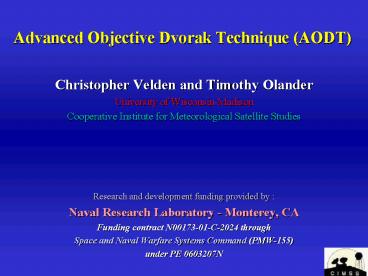Advanced Objective Dvorak Technique AODT - PowerPoint PPT Presentation
1 / 7
Title:
Advanced Objective Dvorak Technique AODT
Description:
AODT algorithm objectively estimates tropical cyclone intensity ... Can be used to estimate storm intensity of any tropical cyclone worldwide. ... – PowerPoint PPT presentation
Number of Views:92
Avg rating:3.0/5.0
Title: Advanced Objective Dvorak Technique AODT
1
Advanced Objective Dvorak Technique (AODT)
- Christopher Velden and Timothy Olander
- University of Wisconsin-Madison
- Cooperative Institute for Meteorological
Satellite Studies - Research and development funding provided by
- Naval Research Laboratory - Monterey, CA
- Funding contract N00173-01-C-2024 through
- Space and Naval Warfare Systems Command (PMW-155)
- under PE 0603207N
2
Advanced Objective Dvorak Technique (AODT)
- AODT algorithm objectively estimates tropical
cyclone intensity - Utilizes global, geostationary, longwave infrared
channel satellite imagery - Based on Dvorak Technique procedures, rules, and
techniques - User only needs to determine/input storm center
location - Objectively determines type of scene being
examined, applies rules based on these scene
types (e.g. eye/no eye, undergoing shear,
formation stage) - Applies time-weighted averaging scheme and
various time-dependent intensity change rules to
account for documented biases in technique - Strengths
- AODT removes inherent subjectivity of operational
Dvorak Technique. - Can be used to estimate storm intensity of any
tropical cyclone worldwide. - Proven statistically to be superior to previous
objective techniques and equal in skill with
estimates obtained from experienced forecasters - Ease of use Can be used by novice forecasters
- Weaknesses
- Inaccurate intensity estimates if objective scene
identification scheme fails - Technique based on typical storm evolution, may
not handle - extreme or non-tropical cases correctly.
3
Advanced Objective Dvorak Technique (AODT)
- Significant Algorithm Upgrades
- Expanded intensity analysis to include entire
storm lifecycle - Added Curved Band analysis for tropical
depressions/tropical storms - Auto-center finding algorithm added to aid
forecasters - Center fix determined from forecast positions and
image analysis techniques - Implemented additional intensity growth/decay
constraint rules - Rule 8 in original EIR/Visible Dvorak Technique
- Added latitude bias correction to final intensity
estimate - Based upon linear regression analysis of data set
- Reduces RMS error by about 10 over previous ODT
versions - Additional Modifications
- Changed Cloud Region Temperature calculation
- Better determine eyewall convection
characteristics (strength, symmetry) - Reduce contamination of temperature calculation
with eye region values - Improved scene identification schemes
- Added more scene types for eye and non-eye cases
- Modified land feature interaction check
4
Advanced Objective Dvorak Technique (AODT)
26 individual tropical cyclones 1995-2002
AODT results improved over previous ODT
version and on par with Operational Center
Estimates
5
(No Transcript)
6
New Eye Scene Classifications
7
New Cloud Scene Classifications































